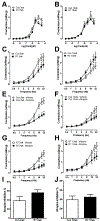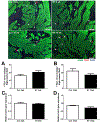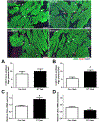Impact of prostatic radiation therapy on bladder contractility and innervation
- PMID: 34015163
- PMCID: PMC8298286
- DOI: 10.1002/nau.24705
Impact of prostatic radiation therapy on bladder contractility and innervation
Abstract
Aims: To determine the effect of prostatic radiation therapy (RT) on bladder contractility and morphology, and axon, or neuron profiles within the detrusor and major pelvic ganglia (MPG) in male rats.
Methods: Male Sprague-Dawley rats (8 weeks) received a single dose of prostatic RT (0 or 22 Gy). Bladders and MPG were collected 2- and 10-weeks post-RT. Detrusor contractile responses to carbachol and electrical field stimulation (EFS) were measured. Bladders were stained with Masson's trichrome, and antibodies for nonspecific neuronal marker, cholinergic nerve marker choline acetyltransferase (ChAT), and alpha-smooth muscle actin. MPG gene expression was assessed by quantitative polymerase chain reaction for ubiquitin carboxy-terminal hydrolase L1 (Uchl1) and Chat.
Results: At 2 weeks post-RT, bladder smooth muscle, detrusor cholinergic axon profiles, and MPG Chat gene expression were increased (p < .05), while carbachol and EFS-mediated contractions were decreased (p < .05). In contrast, at 10 weeks post-RT, nerve-mediated contractions were increased compared with control (p < .05), while bladder smooth muscle, detrusor cholinergic axon profiles, MPG Chat expression, and carbachol contractions had normalized. At both 2- and 10-weeks post-RT, there was no change in detrusor nonspecific axon profiles and MPG Uchl1 expression.
Conclusion: In a rat model, RT of the prostate and MPG was associated with early changes in MPG Chat gene expression, and bladder cholinergic axon profiles and smooth muscle content which resolved over time. After RT recovery, bladder contractility decreased early and increased by 10 weeks. Long-term changes to the MPG and increased bladder cholinergic axons may contribute to RT-induced bladder dysfunction in prostate cancer survivors.
Keywords: bladder dysfunction; pelvic ganglia; prostatic radiation; smooth muscle.
© 2021 Wiley Periodicals LLC.
Conflict of interest statement
Figures




References
-
- Siegel RL, Miller KD, Jemal A. Cancer statistics, 2018. CA Cancer J Clin. 2018;68(1):7–30. - PubMed
-
- Kibel AS, Ciezki JP, Klein EA, et al. Survival among men with clinically localized prostate cancer treated with radical prostatectomy or radiation therapy in the prostate specific antigen era. J Urol. 2012;187(4):1259–1265. - PubMed
-
- Morgan SC, Hoffman K, Loblaw DA, et al. Hypofractionated Radiation Therapy for Localized Prostate Cancer: Executive Summary of an ASTRO, ASCO and AUA Evidence-Based Guideline. J Urol. 2019;201(3):528–534. - PubMed
-
- Wu VWC, Law MYY, Star-Lack J, Cheung FWK, Ling CC. Technologies of image guidance and the development of advanced linear accelerator systems for radiotherapy. Front Radiat Ther Oncol. 2011;43:132–164. - PubMed
Publication types
MeSH terms
Substances
Grants and funding
LinkOut - more resources
Full Text Sources
Other Literature Sources
Miscellaneous

